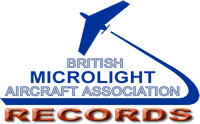 Home
HomeLatest news
How to do records
About maps
Record claim form
Official Observers
Official Observers guide
Observer application form
Sporting licences
Equipment hire
BMAA home page
Calculate & convert
FAI distance calculator
FAI min speed calculator
Wind chill calculator
GPS file format converter
Championship records elapsed time normalization calculator
FAI
Microlight & paramotor World Records
World record claims pending ratification
The rules (Section 10)
The rules (General section)
FAI Licences
Colibri badges
FAI Licence applications
UK RECORDS
UK record claims pending ratification
Landplanes
WL1T (Solo Weightshift)
WL1E (Solo Weightshift, electric)
WL2T (2 seat Weightshift)
WL2E (2 seat Weightshift, electric)
AL1T (Solo 3 Axis)
AL1E (Solo 3 Axis, electric)
AL2T (2 seat, 3 Axis)
AL2E (2 seat 3 Axis, electric)
Paramotors Paratrikes Powered Hang gliders Microlight Autogyros Seaplanes Amphibians Other stuff Site last updated by RMH
PF1Tm (Solo, male)
PF1Tf (Solo, female)
PF1E (Solo, electric)
PF2T (2 Seat)
PF2E (2 Seat, electric)
PL1T (Wheels, Solo)
PL1E (Wheels, Solo, electric)
PL2T (Wheels, 2 seat)
PL2E (Wheels, 2 seat, electric)
WF1T (Solo)
WF1E (Solo, electric)
WF2T (2 Seat)
WF2E (2 Seat, electric)
GL1 (Solo)
GL2 (2 Seat)
WS1 (Solo Weightshift)
WS2 (2 seat Weightshift)
AS1 (Solo 3 Axis)
AS2 (2 seat, 3 Axis)
WM1 (Solo Weightshift)
WM2 (2 seat Weightshift)
AM1 (Solo 3 Axis)
AM2 (2 seat, 3 Axis)
Absolute records
Record statistics
Ann Welch Diploma
Remarkable feats
Grey links indicate no
UK records set in class
30 Apr 2025, 12:55
Maps and measuring distances
A succesful record claim is far more likely if you have a suitable flight recorder on board your microlight or paramotor during a record attempt.
None the less, it is still possible to make a succesful claim using the 'traditional' methods of barograph, turnpoint photos and map but there are several
things to watch for when you are using a map to measure distances.
For most microlight or paramotor records the 1/4 million aviation map is simply not detailed enough to substantiate a claim so you will have to use the 1:50,000 ordnance survey map. Annotated copies of these maps should form the core evidence of your claim.
Any distances which constitute part of a record claim cannot be simply measured off a map, (or read off a GPS), they must be calculated in a specific way. To do this you will need to find the exact latitude and longitude of every significant point on your route (start, turnpoints, finish) and enter them in the distance calculator to find the total distance.
It is not so easy as it might at first seem to extract accurate WGS84 latitudes and longitudes from OS maps.
The UK National Grid
The Ordnance Survey of Great Britain is a Transverse Mercator projection. This is a particularly ideal choice for a tall thin area like Britain in that distances, areas
and angles are well mapped with minimal error.
The OS projection is based on a true origin at 49 degrees North, 2 degrees West which is near the Channel Islands.
From this origin, a square grid is imposed on top of the converging lines of longitude and the curved lines of latitude. Points are located by measuring distances in metres east and north from this true origin. Since this process will introduce distortion as you move away from the central longitude of 2 degrees west, a scale factor of 0.9996012717 is introduced which reduces this distortion - two lines of longitude with zero distortion are thus created. Furthermore, to eliminate the inconvenience of negative values of easting, the concept of a false origin is introduced. A value of 400000 (400 Km) is added to eastings and 100000 (100 Km) subtracted from northings so placing this false origin near the Isles of Scilly. Irish OS maps (which includes Northern Ireland) are based upon a grid with a different false origin off Co. Kerry.
What does this mean?
OS maps all have a latitude and longitude key in the border, but the lines of latitude and longitude across the map are NOT straight and do NOT follow the grid lines in
either axis and what's more, even if you look very carefully at your 1:50,000 OS map and find the small blue + at every 5 minute intersection of lines of latitude
and longitude to get a reasonably accurate position, the one you find is not a correct one relative to the WGS84 datum anyway (it is to the OSGB36 datum which is slightly different).
The only way to get WGS84 latitudes and longitudes is to extract OS grid positions from the map (an explanation of how to do this is on every OS map) and mathematically convert them. There are various utilities out there which will do this, for example Phil Brady's Excel spreadsheet does the trick nicely for British (not Irish) grid references.
When you have got your WGS84 positions, simply enter them into the distance calculator to find the "correct" distances between your turnpoints.
By rmh updated 25 Nov 2018
OS information courtesy of Phil Brady